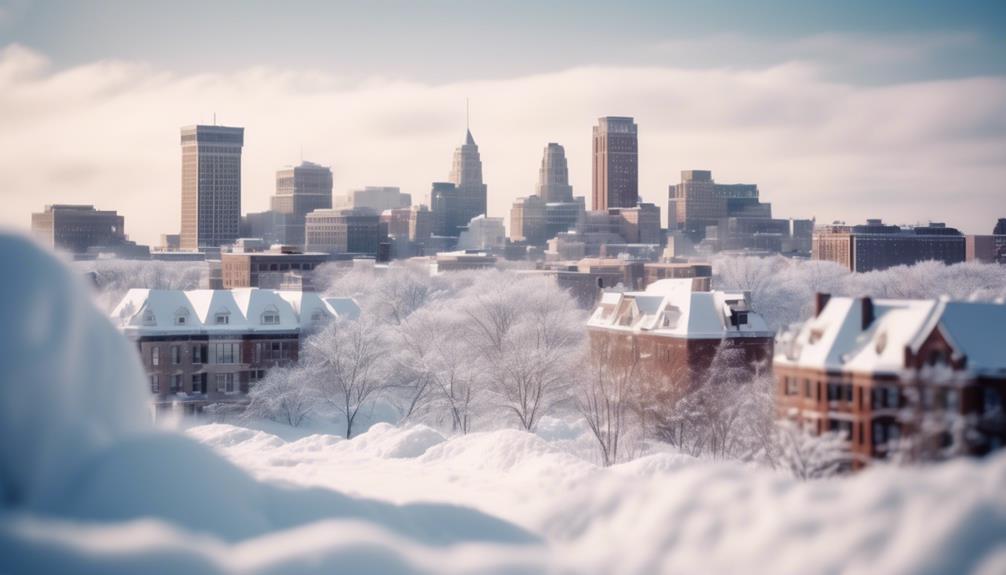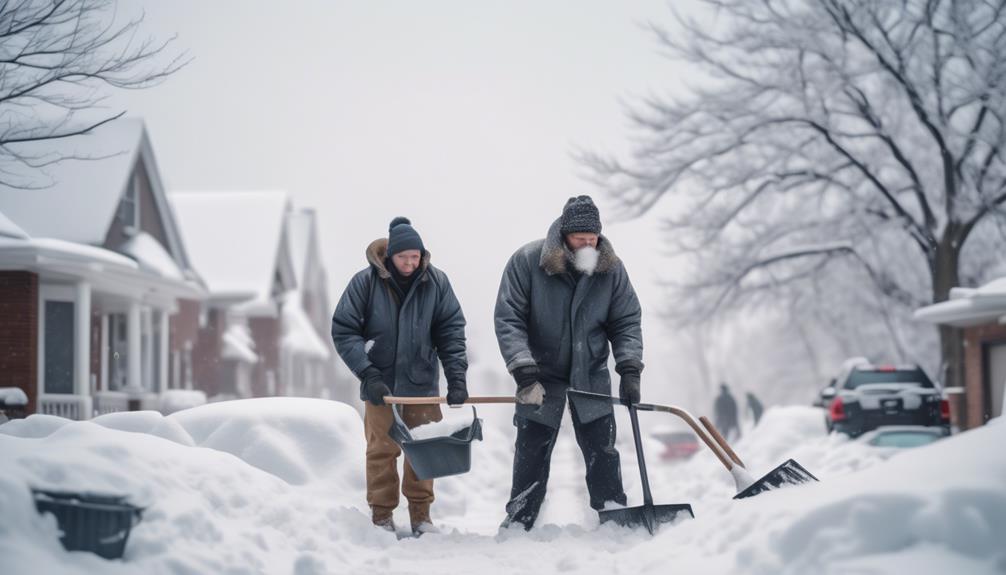Buffalo, NY is no stranger to snowfall, with its reputation for experiencing significant winter weather. The city has seen its fair share of snowstorms and blizzards throughout the years, but just how much snow did Buffalo actually get? Delving into the historical snowfall data and winter storm records reveals fascinating insights on the annual snowfall totals and the impact it has on daily life in this resilient city. From record-breaking snowfalls to the challenges faced by residents, this discussion will provide an in-depth analysis of Buffalo's snowy winters and offer valuable preparedness tips for those living in this winter wonderland. So, let's explore the fascinating world of snowfall in Buffalo, NY and uncover the remarkable snowfall figures that have shaped this city's history.
Key Takeaways
- Buffalo, NY is known for its heavy snowfall, with an average of 94 inches per year.
- Snowfall amounts in Buffalo can vary significantly from year to year, with some years experiencing over 200 inches of snow.
- Rising global temperatures could lead to more intense winter storms and heavier snowfall in the future.
- Understanding historical snowfall data and winter storm records is crucial for predicting future snowfall and preparing for its impacts.
Historical Snowfall Data

Historical snowfall data in Buffalo, NY provides a factual and comprehensive record of the amount of snow received in the region over the years. This data is essential for understanding the winter weather patterns in Buffalo and assessing the potential impacts of climate change on snowfall.
Buffalo, often referred to as the "Snow Capital of the United States," is known for its heavy snowfall during the winter months. The historical data reveals that the city experiences an average annual snowfall of around 94 inches. However, there have been substantial variations in snowfall amounts from year to year.
An analysis of the historical data shows that Buffalo has witnessed both periods of above-average and below-average snowfall. For instance, the winter of 1976-1977 saw an unprecedented 199.4 inches of snow, while the winter of 2011-2012 recorded only 36.7 inches. These variations highlight the dynamic nature of winter weather patterns in the region.
Climate change impacts on winter weather patterns in Buffalo are a topic of interest and concern. While it is challenging to attribute specific snow events to climate change, scientists suggest that rising global temperatures could lead to more intense winter storms. Warmer air can hold more moisture, increasing the potential for heavy snowfall.
Understanding the historical snowfall data is crucial for the residents of Buffalo, as it helps them prepare for severe winter weather events and make informed decisions about snow removal, infrastructure maintenance, and emergency response planning. Additionally, this data provides valuable insights for policymakers and researchers studying the impacts of climate change on winter weather patterns.
Winter Storm Records
Winter storm records provide valuable insights into the severity and frequency of snowstorms in Buffalo, NY. Analyzing winter storm trends allows authorities and residents to better understand the impact of these extreme weather events and develop effective snow removal strategies.
Buffalo, known for its notoriously harsh winters, has experienced numerous significant snowstorms throughout its history. These storms have left lasting impressions on the city and its residents. By examining past winter storm records, we can identify patterns and trends that help predict future snowfall and prepare accordingly.
One notable winter storm in Buffalo's history occurred in November 2014, when the city experienced a record-breaking snowfall of 7 feet in just four days. This event, known as the "Snowvember" storm, caused widespread disruption and challenged the city's snow removal capabilities. It highlighted the importance of efficient snow removal strategies and the need for preparedness in the face of extreme winter weather.
Winter storm records also provide data on the frequency and intensity of snowstorms in Buffalo. By analyzing this information, authorities can evaluate their current snow removal strategies and make necessary adjustments to ensure the safety and well-being of residents. This could include increasing snow removal equipment and personnel, implementing more effective snow removal routes, and improving communication channels with the public during snow emergencies.
Snowfall Totals by Year

Snowfall totals in Buffalo, NY vary significantly from year to year, providing valuable data on the city's winter weather patterns. Understanding the snowfall averages can help residents and businesses prepare for the winter season and develop effective snow removal strategies. Here are some key points to consider:
- Annual snowfall averages in Buffalo typically range from 90 to 110 inches. However, there have been years when the city has experienced significantly higher snowfall totals, reaching over 200 inches. These variations highlight the city's reputation as a snowy destination.
- Extreme snowfall events have occurred in Buffalo throughout history. The infamous Blizzard of 1977, for example, brought over 100 inches of snow in just a few days, resulting in travel disruptions and economic impacts. Such events serve as reminders of the importance of preparedness and efficient snow removal strategies.
- Snow removal strategies in Buffalo are crucial for maintaining safe road conditions and ensuring the city continues to function during winter storms. The city employs a combination of plowing, salting, and snow hauling to clear the streets. Additionally, residents are encouraged to follow parking regulations and cooperate with snow removal efforts to facilitate the process.
Understanding the snowfall patterns and averages in Buffalo, NY is essential for developing effective snow removal strategies and preparing for the winter season. By staying informed and proactive, both residents and businesses can navigate the challenges that come with heavy snowfall and ensure the safety and accessibility of the city's infrastructure.
Impact on Daily Life
The amount of snowfall in Buffalo, NY has a significant impact on the daily lives of its residents and the functioning of the city. The effect on transportation is one of the most noticeable consequences of heavy snowfall. The accumulation of snow on roads and highways can make driving conditions hazardous, leading to increased accidents and traffic congestion. In severe cases, roads may become impassable, leaving residents stranded in their homes and disrupting the flow of goods and services.
Snowstorms also have a significant impact on the operation of schools in Buffalo. When snowfall reaches significant levels, school closures become necessary to ensure the safety of students and staff. These closures disrupt the daily routine of families and can pose challenges for working parents who need to find alternative childcare arrangements. Additionally, school closures may affect students' education, as missed days of instruction need to be made up later in the academic year.
The impact of heavy snowfall extends beyond transportation and schools. It can also disrupt other essential services, such as power supply and public transportation. Snow accumulation on power lines may cause outages, leaving residents without electricity and heating during frigid winter temperatures. Public transportation systems, including buses and trains, may face delays or suspensions due to unsafe road conditions or equipment malfunctions caused by the snow.
Preparedness Tips for Buffalo Residents

Buffalo residents can enhance their preparedness for heavy snowfall by implementing a comprehensive winter weather plan. Winter storms can bring significant challenges, but with proper preparation, residents can minimize the impact on their daily lives. Here are some essential tips to help Buffalo residents be ready for the snow:
- Winter driving: When driving in snowy conditions, it is important to adjust your driving habits accordingly. Slow down, increase your following distance, and allow extra time to reach your destination. Ensure that your vehicle is equipped with snow tires or chains for improved traction. Additionally, keep an emergency kit in your car with items such as a flashlight, blanket, food, water, and a first aid kit.
- Snow removal equipment: Having the necessary equipment to remove snow from your property is crucial during heavy snowfall. Make sure you have a reliable snow shovel or snow blower to clear your driveway and walkways. Stock up on ice melt or sand to prevent slips and falls. It is also advisable to have a backup power generator in case of power outages.
- Emergency supplies: As part of your winter weather plan, it is essential to have an emergency supply kit in your home. This kit should include non-perishable food, water, medications, batteries, and a battery-powered radio. It is also wise to have extra blankets, warm clothing, and a backup heating source, such as a portable heater or fireplace.
Frequently Asked Questions
What Is the Average Temperature in Buffalo During the Winter Season?
During the winter season, Buffalo experiences an average temperature that can vary. The average temperature in Buffalo during the winter months typically ranges from around 20 to 30 degrees Fahrenheit. This data is based on historical weather records and provides an objective assessment of the typical winter climate in Buffalo. It is important to note that actual temperatures can fluctuate from year to year, and it is advisable to consult current weather reports for the most accurate and up-to-date information.
How Does Buffalo Compare to Other Cities in Terms of Snowfall?
Buffalo, NY is renowned for its significant snowfall, making it one of the snowiest cities in the United States. The city experiences heavy snowstorms and lake-effect snow due to its proximity to Lake Erie. Buffalo holds numerous snowfall records, including the most snowfall in a single season. Comparatively, when evaluating snowfall among cities, Buffalo often surpasses many other locations in terms of total snow accumulation. The city's climate and geographical factors contribute to its notable snowfall amounts.
Are There Any Winter Activities or Festivals That Take Place in Buffalo?
Buffalo, NY is known for its vibrant winter activities and festivals. Despite its reputation for heavy snowfall, the city embraces its wintery climate by offering a wide range of activities for residents and visitors alike. From ice skating at Canalside to the annual Powder Keg Festival, Buffalo provides plenty of opportunities to enjoy the snowy season. Additionally, the city's efficient transportation system ensures that residents can navigate through the snow-covered streets. Despite occasional snowstorms, Buffalo's average winter temperature remains relatively mild compared to other cities with similar snowfall levels.
How Does Snow Affect Transportation in Buffalo?
Snow in Buffalo can have a significant impact on transportation. Snow plowing operations are essential to keep the roads clear and safe for travel. However, heavy snowfall can lead to disruptions in public transportation, such as delays or route changes. The city's transportation authorities work diligently to minimize the impact of snow on transportation services. By implementing proper snow removal strategies and closely monitoring weather conditions, they strive to ensure the smooth operation of transportation systems during snowy periods.
Are There Any Famous Snowstorms in Buffalo's History?
Buffalo, New York has a history of famous snowstorms that have had a significant impact on the city's economy. These snowstorms, known for their intensity and accumulation, have caused transportation disruptions, school and business closures, and increased costs for snow removal and infrastructure repairs. Some notable snowstorms include the Blizzard of 1977 and the Snowvember storm of 2014. These events highlight the resilience of the Buffalo community in the face of challenging weather conditions.
Conclusion
In conclusion, Buffalo, NY experiences significant snowfall each winter, with records dating back to the 1800s. Winter storms can bring heavy snow accumulation, impacting daily life in the city. Residents should be prepared for these weather conditions by ensuring they have necessary supplies and staying informed about road conditions. As the saying goes, "Preparation is the key to success," and in Buffalo, being prepared for the winter weather is crucial for residents to navigate their daily lives safely and efficiently.

